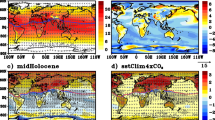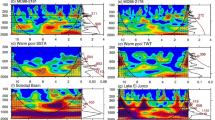Abstract
The autumn precipitation over the Sichuan Basin (APSB) experienced a significant wet-to-dry shift around the mid-1980s during the 1961–2010 period. Thus, the dataset is divided into two subperiods, 1961–1985 (P1) and 1986–2010 (P2), which are denoted as the wet period and dry period, respectively. The possible mechanisms accounting for the wet-to-dry shift in the APSB are investigated using both observational data and a baroclinic atmospheric model. Analysis shows that the sea surface temperature (SST) in the tropical Indian-western Pacific (TIWP) regions displays continuous warming during the period under examination, which may intensify the ascent motion over the warm pool and favor the descent motion over the Sichuan Basin. Meanwhile, the Gill-type atmospheric response to anomalous TIWP warm SST is accompanied by anomalous northerly winds prevailing over central and Southwest China. Both the intensified descent motion and anomalous northerly winds over central and Southwest China favor the switch to dry conditions in the APSB. Further analysis shows that the decadal changes in the North Atlantic SST lead to an atmospheric wave pattern prevailing over the extratropical Eurasian continent. An anomalous cyclone over central-eastern Eurasia, which is one component of the wave pattern, is accompanied by significant northerly winds penetrating southward to central China. These northerly winds can cause more-than-normal snow cover around Lake Baikal, which may in turn modulate the atmospheric circulation through positive feedback and therefore result in intensified northerly winds, favorable for the switch to the anomalous dry state of the APSB.












Similar content being viewed by others
References
ArcGIS Online basemaps (2020) National Geographic World Map. https://www.arcgis.com/home/item.html?id=b9b1b422198944fbbd5250b3241691b6#
Bannister D, Herzog M, Graf HF, Scott Hosking J, Short CA (2017) An assessment of recent and future temperature change over the Sichuan basin, China, using CMIP5 climate models. J Climate 30:6701–6722. https://doi.org/10.1175/JCLI-D-16-0536.1
Brodzik M, Armstrong R (2013) Northern Hemisphere EASE-Grid 2.0 Weekly Snow Cover and Sea Ice Extent. Version 4. National Snow and Ice Data Center, Boulder, CO, digital media. https://nsidc.org/data/docs/daac/nsidc0046_nh_ease_snow_seaice.gd.html
Chen W, Lan XQ, Wang L, Ma Y (2013) The combined effects of the ENSO and the Arctic Oscillation on the winter climate anomalies in East Asia. Chin Sci Bull 58:1355–1362. https://doi.org/10.1007/s11434-012-5654-5
Dai X-G, Fu C-B, Wang P (2005) Interdecadal change of atmospheric stationary waves and North China drought. Chin Phys 14:850–858. https://doi.org/10.1088/1009-1963/14/4/038
Duan AM, Wu GX (2005) Role of the Tibetan Plateau thermal forcing in the summer climate patterns over subtropical Asia. Climate Dyn 24:793–807. https://doi.org/10.1007/s00382-004-0488-8
Duan H-X, Wang S-P, Feng J-Y (2014) Drought events and its influence in 2013 in China. J Arid Meteor 32:310–316. https://doi.org/10.11755/j.issn.1006-7639(2014)-02-0310
Feng J, Chen W, Tam CY, Zhou W (2011) Different impacts of El Niño and El Niño Modoki on China rainfall in the decaying phases. Int J Climatol 31:2091–2101. https://doi.org/10.1002/joc.2217
Gao H, Yang S (2009) A Severe drought event in northern China in winter 2008–2009 and the possible influences of La Niña and Tibetan Plateau. J Geophys Res Atmos. https://doi.org/10.1029/2009JD012430
Heddinghaus TR, Sabol P (1991) A review of the palmer drought severity index and where do we go from here? In: Proc. 7th conf. on applied climatology, American meteorological society, pp 242–246
Hu ZZ, Yang S, Wu R (2003) Long-term climate variations in China and global warming signals. J Geophys Res D Atmos. https://doi.org/10.1029/2003jd003651
Huang RH, Liu Y, Wang L, Wang L (2012) Analyses of the causes of severe drought occurring in Southwest China from the fall of 2009 to the spring of 2010. Chin J Atmos Sci 36:443–457. https://doi.org/10.3878/j.issn.1006-9895.2011.11101
Huang B et al (2017) Extended reconstructed sea surface temperature, version 5 (ERSSTv5): upgrades, validations, and intercomparisons. J Climate 30:8179–8205. https://doi.org/10.1175/JCLI-D-16-0836.1
Jia X, Cao DR, Ge JW, Wang M (2018) Interdecadal change of the impact of Eurasian snow on spring precipitation over Southern China. J Geophys Res Atmos 123:10092–10108. https://doi.org/10.1029/2018JD028612
Jiang J, Zhou T, Chen X, Zhang L (2020) Future changes in precipitation over Central Asia based on CMIP6 projections. Environ Res Lett. https://doi.org/10.1088/1748-9326/ab7d03
Kalnay E et al (1996) The NCEP/NCAR 40-year reanalysis project. Bull Amer Meteor Soc 77:437–471. https://doi.org/10.1175/1520-0477(1996)077%3c0437:TNYRP%3e2.0.CO;2
Karl TR, Riebsame WE (1984) The identification of 10- to 20-year temperature and precipitation fluctuations in the contiguous United States. J Climate Appl Meteor 23:950–966. https://doi.org/10.1175/1520-0450(1984)023%3c0950:TIOTYT%3e2.0.CO;2
Klein SA, Hartmann DL (1993) The seasonal cycle of low stratiform clouds. J Climate 6:1587–1606. https://doi.org/10.1175/1520-0442(1993)006%3c1587:TSCOLS%3e2.0.CO;2
National Meteorological Information Center (2012) Assessment report of China’s ground precipitation 0.5°× 0.5° gridded dataset (V2.0). National Meteorological Information Center, Beijing
Peng J, Zhang Q, Bueh C (2007) On the characteristics and possible causes of a severe drought and heat wave in the Sichuan-Chongqing region in 2006. Climate Environ Res 12:464–474
Preethi B, Mujumdar M, Kripalani RH, Prabhu A, Krishnan R (2017) Recent trends and teleconnections among South and East Asian summer monsoons in a warming environment. Clim Dyn 48:2489–2505
Qian C, Zhou T (2014) Multidecadal variability of North China aridity and its relationship to PDO during 1900–2010. J Climate 27:1210–1222. https://doi.org/10.1175/JCLI-D-13-00235.1
Qin M, Li D, Dai A, Hua W, Ma H (2018) The influence of the Pacific Decadal Oscillation on North Central China precipitation during boreal autumn. Int J Climatol 38:e821–e831. https://doi.org/10.1002/joc.5410
Sun S et al (2016) Shift in potential evapotranspiration and its implications for dryness/wetness over Southwest China. J Geophys Res 121:9342–9355. https://doi.org/10.1002/2016JD025276
Sun S et al (2017) Attributing the changes in reference evapotranspiration in Southwestern China using a new separation method. J Hydrometeorol 18:777–798. https://doi.org/10.1175/JHM-D-16-0118.1
Takaya K, Nakamura H (2001) A formulation of a phase-independent wave-activity flux for stationary and migratory quasigeostrophic eddies on a zonally varying basic flow. J Atmos Sci 58:608–627. https://doi.org/10.1175/1520-0469(2001)058%3c0608:AFOAPI%3e2.0.CO;2
Tan H, Cai R, Chen J, Huang R (2017) Decadal winter drought in Southwest China since the late 1990s and its atmospheric teleconnection. Int J Climatol 37:455–467. https://doi.org/10.1002/joc.4718
Wang L, Chen W (2012) Characteristics of multitimescale variabilities of the drought over last 100 years in Southwest China. Adv Meteor Sci Technol 2:21–26
Wang L, Chen W (2014) A CMIP5 multimodel projection of future temperature, precipitation, and climatological drought in China. Int J Climatol 34(6):2059–2078
Wang L, Chen W, Zhou W, Huang G (2015) Drought in Southwest China: a review. Atmos Ocean Sci Lett 8:339–344. https://doi.org/10.3878/AOSL20150043
Wang L, Chen W, Zhou W, Huang G (2016) Understanding and detecting superextreme droughts in Southwest China through an integrated approach and index. Quart J Roy Meteor Soc 142:529–535. https://doi.org/10.1002/qj.2593
Wang L, Huang G, Chen W, Zhou W, Wang W (2018) Wet-to-dry shift over Southwest China in 1994 tied to the warming of tropical warm pool. Climate Dyn 51:3111–3123. https://doi.org/10.1007/s00382-018-4068-8
Wang M, Gu Q, Jia X, Ge J (2019a) An assessment of the impact of Pacific Decadal Oscillation on autumn droughts in North China based on the Palmer drought severity index. Int J Climatol 39:5338–5350. https://doi.org/10.1002/joc.6158
Wang M, Jia XJ, Ge JW, Qian QF (2019b) Changes in the relationship between the interannual variation of eurasian snow cover and spring SAT over Eastern Eurasia. J Geophys Res Atmos 124:468–487. https://doi.org/10.1029/2018JD029077
Watanabe M, Kimoto M (2000) Atmosphere-ocean thermal coupling in the North Atlantic: a positive feedback. Quart J Roy Meteor Soc 126:3343–3369. https://doi.org/10.1256/smsqj.57016
Wu R, Kirtman BP (2007) Observed relationship of spring and summer East Asian rainfall with winter and spring Eurasian snow. J Climate 20:1285–1304. https://doi.org/10.1175/JCLI4068.1
Ye K, Wu R, Liu Y (2015) Interdecadal change of Eurasian snow, surface temperature, and atmospheric circulation in the late 1980s. J Geophys Res 120:2738–2753. https://doi.org/10.1002/2015JD023148
Zhang K, Qian X, Liu P, Xu Y, Cao L, Hao Y, Dai S (2017) Variation characteristics and influences of climate factors on aridity index and its association with AO and ENSO in northern China from 1961 to 2012. Theor Appl Climatol 130:523–533. https://doi.org/10.1007/s00704-016-1887-6
Acknowledgements
The NCEP/NCAR Reanalysis 1 data are provided by the National Oceanic and Atmospheric Administration (NOAA) Physical Sciences Laboratory (https://www.esrl.noaa.gov/psd/data/gridded/). The original weekly Climate Data Record of Northern Hemisphere Snow Cover Extent is available from http://nsidc.org/data/. The NOAA Extended Reconstructed Sea Surface Temperature (SST) V5 data can be accessed through https://psl.noaa.gov/data/gridded/data.noaa.ersst.v5.html. The Niño 3.4 index is obtained from the Earth System Research Laboratory of the National Oceanic and Atmospheric Administration (NOAA) (https://www.esrl.noaa.gov/psd/data/climateindices/list). This research is funded by National Natural Science Foundation of China grants (42075050 and 41530425).
Author information
Authors and Affiliations
Corresponding author
Additional information
Publisher's Note
Springer Nature remains neutral with regard to jurisdictional claims in published maps and institutional affiliations.
Rights and permissions
About this article
Cite this article
Jia, X., Gu, Q., Qian, Q. et al. Wet-to-dry climate shift of the Sichuan Basin during 1961–2010. Clim Dyn 57, 671–685 (2021). https://doi.org/10.1007/s00382-021-05734-8
Received:
Accepted:
Published:
Issue Date:
DOI: https://doi.org/10.1007/s00382-021-05734-8




